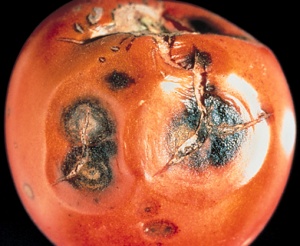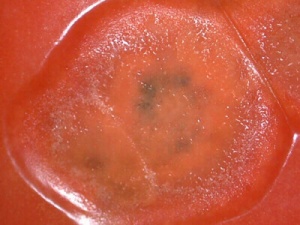Anthracnose of Tomato
 Causal Agent
Causal Agent
The fungus, Colletotrichum phomoides
Hosts
Tomato
Symptoms
 Anthracnose is a common and widespread rot of ripe or overripe tomato fruit. Symptoms
are rare on green fruit. Symptoms on ripe fruit are small, sunken, circular spots
that may increase in size up to 1/2 inch in diameter. The center of older spots later
become blackish. Spots may become numerous in severe cases and secondary rotting organisms
may invade anthracnose lesions to completely rot infected fruit. The fungus forms
small, dark survival structures called sclerotia in the centers of fruit spots. These
sclerotia survive in soil for up to three years and cause infections either directly
or by producing secondary spores. Green fruit are infected but do not show symptoms
until ripening. The fungus then spreads from infected to healthy fruit as spores are
splashed by rain or overhead irrigation, or by pickers working wet plants. Anthracnose
is favored by warm rainy weather, overhead irrigation, and heavy defoliation caused
by early blight.
Anthracnose is a common and widespread rot of ripe or overripe tomato fruit. Symptoms
are rare on green fruit. Symptoms on ripe fruit are small, sunken, circular spots
that may increase in size up to 1/2 inch in diameter. The center of older spots later
become blackish. Spots may become numerous in severe cases and secondary rotting organisms
may invade anthracnose lesions to completely rot infected fruit. The fungus forms
small, dark survival structures called sclerotia in the centers of fruit spots. These
sclerotia survive in soil for up to three years and cause infections either directly
or by producing secondary spores. Green fruit are infected but do not show symptoms
until ripening. The fungus then spreads from infected to healthy fruit as spores are
splashed by rain or overhead irrigation, or by pickers working wet plants. Anthracnose
is favored by warm rainy weather, overhead irrigation, and heavy defoliation caused
by early blight.
Control
Harvest fruit as soon as possible after ripening. Avoid excessive overhead irrigation or use drip irrigation to reduce moisture levels on fruit and humidity in the plant canopy. Fungicide sprays used to control leaf diseases reduce losses from anthracnose when applied on a regular schedule and in a manner to achieve thorough fruit coverage. A three-year rotation may also reduce chances for infection. Please contact your local county extension office for current information.
